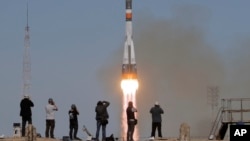A U.S. astronaut and Russian cosmonaut are safe following an emergency return to Earth minutes after launching on what was supposed to be a mission to the International Space Station.
The U.S. National Aeronautics and Space Administration (NASA) said a booster on the Soyuz spacecraft failed after it took off Thursday from the Soviet-era cosmodrome in Baikonur, Kazakhstan.
"At that point, per the standard procedure, an abort was initiated," International Space Station Operations Integration Manager Kenny Todd told reporters.
WATCH: Nick Hague Talks to VOA Before Takeoff
"My heart was beating hard," astronaut Reid Weisman said of the moment he heard the booster had malfunctioned during his colleagues' launch.
It was the latest in a string of recent failures for the Russian space program, which also takes American astronauts to the station.
Russian officials said they are investigating the incident, adding that all manned space flight missions would be suspended until investigators figure out what went wrong.
Officials said U.S. astronaut Nick Hague and Roscosmos' Alexei Ovchinin experienced 6 to 7 times Earth's gravity, followed by a brief moment of weightlessness, as they separated from the booster before falling to Earth.
Rescuers reached the crew after they landed in Kazakhstan, and both were in good condition. They are now reunited with their families.
Thursday was supposed to be Hague's first time in space.
Hague, who is an Air Force colonel, was the first member of his class to be assigned to a mission. Todd said there was "no doubt" Hague would be selected for another mission, but it was "yet to be determined" when that would occur.
In an interview with VOA prior to the launch, Hague said he was excited and ready, but also nervous.
"Sitting on top of a rocket for the first time and being shot into space, you know, how can you not be nervous?" he said.
Hague spent the last five years preparing for his mission. When he gets the chance, he will serve as a flight engineer on the International Space Station, doing everything from maintenance of the aircraft to scientific research to study the effects of weightlessness.
The International Space Station is the largest space collaboration ever. Fifteen countries built and operate the live-in satellite, an "unprecedented" feat, according to John Logsdon, a professor emeritus at George Washington University's Space Policy Institute.
"One of the real payoffs with benefits is to demonstrate peaceful collaboration, not only between allies, but between the United States and Russia, even in spite of all the current political tensions between the two countries," Logsdon said.
Hague told VOA he enjoys working with space explorers from all over the country and world.
Typically, five to seven astronauts man the ISS at one time. Only about 250 people have ever lived on the International Space Station, which celebrates its 20th year in orbit next month.








